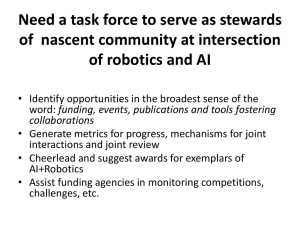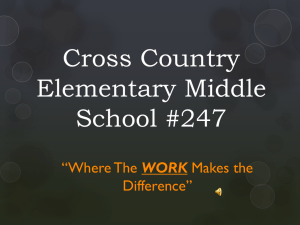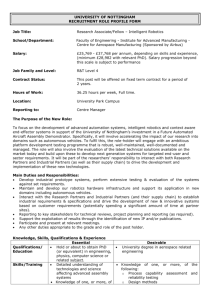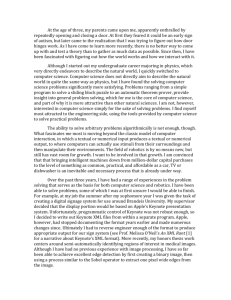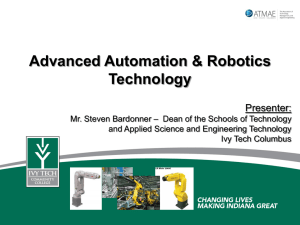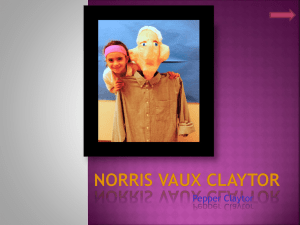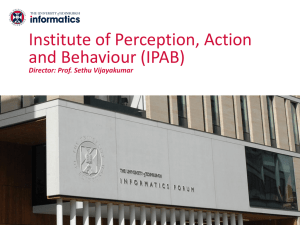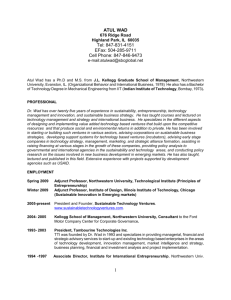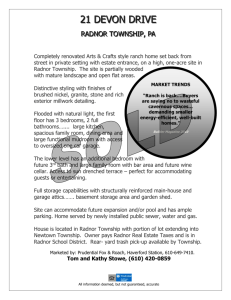Radnor Educational Foundation EITC Programs
advertisement
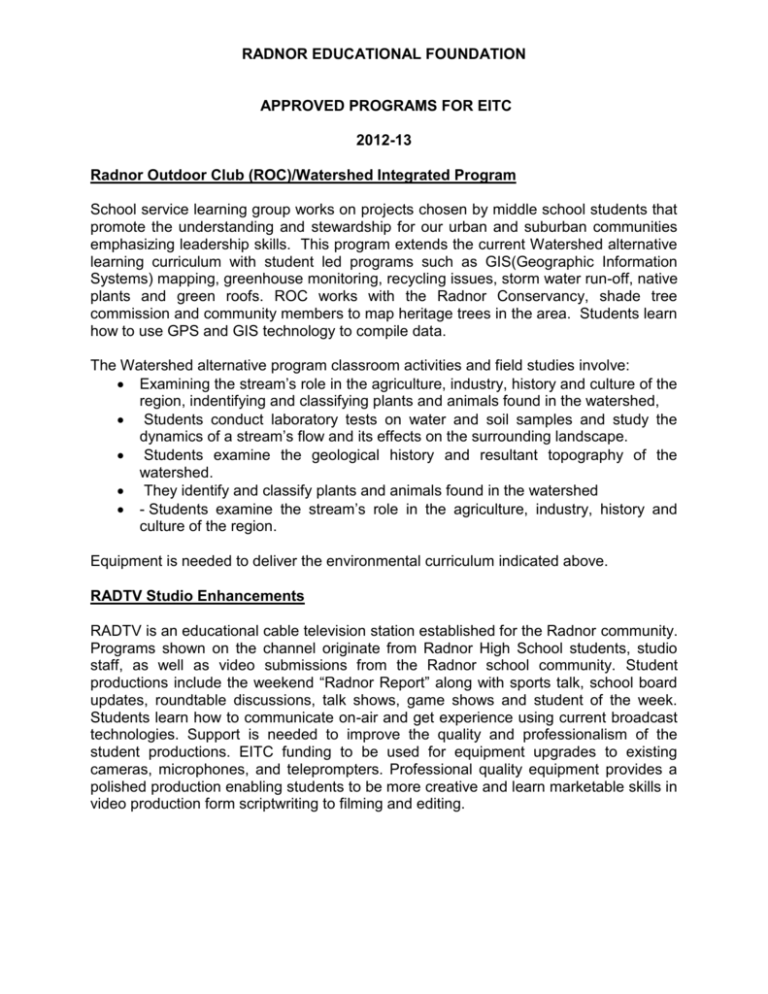
RADNOR EDUCATIONAL FOUNDATION APPROVED PROGRAMS FOR EITC 2012-13 Radnor Outdoor Club (ROC)/Watershed Integrated Program School service learning group works on projects chosen by middle school students that promote the understanding and stewardship for our urban and suburban communities emphasizing leadership skills. This program extends the current Watershed alternative learning curriculum with student led programs such as GIS(Geographic Information Systems) mapping, greenhouse monitoring, recycling issues, storm water run-off, native plants and green roofs. ROC works with the Radnor Conservancy, shade tree commission and community members to map heritage trees in the area. Students learn how to use GPS and GIS technology to compile data. The Watershed alternative program classroom activities and field studies involve: Examining the stream’s role in the agriculture, industry, history and culture of the region, indentifying and classifying plants and animals found in the watershed, Students conduct laboratory tests on water and soil samples and study the dynamics of a stream’s flow and its effects on the surrounding landscape. Students examine the geological history and resultant topography of the watershed. They identify and classify plants and animals found in the watershed - Students examine the stream’s role in the agriculture, industry, history and culture of the region. Equipment is needed to deliver the environmental curriculum indicated above. RADTV Studio Enhancements RADTV is an educational cable television station established for the Radnor community. Programs shown on the channel originate from Radnor High School students, studio staff, as well as video submissions from the Radnor school community. Student productions include the weekend “Radnor Report” along with sports talk, school board updates, roundtable discussions, talk shows, game shows and student of the week. Students learn how to communicate on-air and get experience using current broadcast technologies. Support is needed to improve the quality and professionalism of the student productions. EITC funding to be used for equipment upgrades to existing cameras, microphones, and teleprompters. Professional quality equipment provides a polished production enabling students to be more creative and learn marketable skills in video production form scriptwriting to filming and editing. Anatomy and Physiology at Radnor High School This advanced course studies the body’s structures and respective functions at the molecular/biochemical, cellular, tissue, organ, systemic, and organism levels. Students explore the body through laboratory investigations, models, diagrams, and comparative studies of the anatomy of the cat. The study of anatomy and physiology prepares students for a variety of career endeavors such as health care, sports medicine, and fitness careers, as well as for taking an active part in their own health and wellness. EITC funds to be used for equipment purchases necessary to deliver the curriculum. What’s Worth Reading Bookfolios Students in 3rd through 5th grade will use the web quest “What’s Worth Reading” to create book folios. To encourage self-selected reading, students will have the opportunity to review books to encourage other to read. Using the web quest, students will be able to determine the genre of the book, preview reviews by others, write their own review, design their own covers and/or have the book covers scanned, write about themselves, and incorporate a digital photo. Book folios will be available in the school library encouraging self-selected reading. This program was designed to align curriculum to standards involving reading and writing through the use of technology. The project encourages students to read and respond to literature in a meaningful way through technology. It will spark increased reading and self-selection of appropriate texts by students and provides a reference for teachers. Radnor Robotics Team This after-school Robotics Team promotes interest and extends the current math, science, technology and engineering curriculum offered at the high school level. Students are challenged to build a robot using the Vex Robotics Design System to compete in the FIRST VEX Challenge, a mid-level robotics competition. The “RaiderBot” is capable of acquiring balls from the floor. Students programmed the robot controls using a variation of C programming language. The student competition includes a 2 minute operator controlled match using board sensors and student written control codes to navigate the fields, collect balls and score. This program creates mentoring relationships between students and professional in the fields of science, math, engineering, etc and enhances the current curriculum in a creative way. RaiderBots Technology at Radnor Middle School GATEWAYS is an advanced alternative to the traditional eighth grade program of study using the Project Lead the Way’s (PLTW) Gateway to Technology (GTT) program as the core while incorporating strands of the current eighth grade curriculum. Classroom instruction is one third theory and two-thirds application and gives students meaningful, hands-on experience in problem-solving, teamwork and project-based learning with cutting edge advanced curriculum. It helps students explore math, science, and technology while challenging and engaging the natural curiosity of eighth graders. “RaiderBots at RMS” introduces automation and robotics technology to students allowing them to design and build automated systems incorporating the principles of electronics, physics, and robotics to gain an enriched understanding of the contemporary mechanized world. Students will engage in local, regional and statewide robotics competitions showcasing the practical knowledge learned in their studies and have access to robotics computer applications. Autodesk Inventor software helps students build, apply, and test their skills giving them a competitive advantage of handson training. Gateways Space and Flight Unit introduces students to aeronautics, space and the use of design used to help make aerospace engineering an important field. Students learn about Newton’s Laws of Motion, forces, rockets, propulsion, and what makes things fly. Students acquire and apply knowledge and skills in engineering problem solving and explore the many aspects of aerospace engineering. WeDo Lego Robotics Program/ Elementary Schools Students work with Mindstorm robotics equipment to model real-life mechanisms that will allow for creativity, logic and enhance problem-solving skills. Mindstorm converts classroom learning into a hands-on robotics laboratory. Program is an extension of the WeDo Lego robotics program offered to gifted and interested students at all elementary schools. RADNOR GREEN: Outdoor Environmental Classrooms A campus-based interactive environmental program introducing in-the-field nature learning opportunities for all elementary schools has been established. The program consists of campus improvements to create outdoor learning spaces and demonstration garden areas to enhance habitat for birds, insects and other species and to provide teaching materials to facilitate meaningful use of the outdoor learning sites. The project provides demonstration sites to model improved habitat stewardship practices and environmental education experiences. Creating improved habitats for birds, insects and other animals enhances the life science curriculum at every grade level. Aerospace Engineering-PLTW(Project Lead the Way) Through hands-on engineering projects developed with NASA, students learn about aerodynamics, astronautics, space-life sciences, and systems engineering which includes the study of intelligent vehicles like the Mars rovers Spirit and Opportunity. PERFORMING ARTS at RADNOR HIGH SCHOOL The performing arts at Radnor High School offer opportunities to a wide diversity of the school population. Students perform and create both on and off of the stage. In the performing arts, students receive training in performance, while at the same time building self esteem and confidence in the performance environment. The same experience is possible in the technical environment of the performing arts. Utilizing the latest technologies in lighting and visual effects; sound and audio composition; set design; video and audio recording; and digital music composition, students will gain additional advantage through valuable experience with the tools of a trade that not only is artistically rewarding, but is also an ever growing field in today's technologically evolving world. Currently, educational standards for the theater classroom include aspects of technical theater. The advanced theater course will offer students set, sound, and lighting design as an extension of the curriculum. With this innovative EITC opportunity, theatrical and classroom facilities will be enhanced by technological updates giving students hands on training with the latest technologies in sound, design, composition, lighting, and visual effects. In addition, students will learn how these new technologies might enhance the quality of life through environmentally friendly technology, working with equipment, specifically in lighting, that utilizes green, energy efficient LED modules, saving energy resources while enhancing the quality and complexity of our students' concerts and productions. EITC funds would be used to update current facilities with these latest technologies, and provide support and training from professional technicians. With this innovative experience, our students could be prepared to pursue technical careers in digital music synthesis, recording, and mixing; professional theatrical direction and set design, as well as lighting and sound design; radio, television, and film; Apple technology, the standard in technical and musical application; and other media pursuits, such as A/V support to businesses and/or other institutions, as well as online applications of these concepts.
